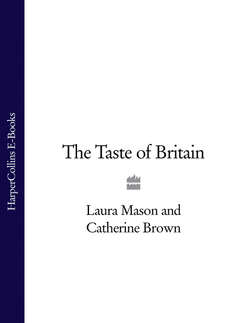Читать книгу The Taste of Britain - Hugh Fearnley-Whittingstall - Страница 174
HISTORY:
ОглавлениеAlthough it must remain uncertain, it does appear that the Anglo-Saxon word beor refers to an alcoholic apple-based beverage. In Norman-French dialect, the word bère for cider survives to this day. Whether cider existed in early England or not, it is thought the art was stimulated by contacts with Normandy after the Conquest, and that cider-making was at first strongest in the South-Eastern counties of Sussex and Kent (Davies, 1993). But there are also many early references to cider in the West Country, including from the 1100s in Gloucestershire and the 1200s in Devon.
Cider from western Britain is distinguished by the use of apples specifically grown for cider-making. This practice has been current for at least 400 years. During the seventeenth century cider became a gentleman’s drink, equated with wine. In Herefordshire, much attention was paid to cider apples and methods. Advances at this time included greater selection of apples, refinement of storage and crushing techniques, and the invention of glass bottles strong enough to withstand a secondary fermentation. Celia Fiennes, travelling through Britain in the late seventeenth century, noted the good quality of Hereford cider.
In the eighteenth century cider sank on the social scale: there was increased competition from imported wine; middlemen sold inferior weak brews; and an epidemic of lead poisoning attracted opprobrium (French, 1982). Competition from wine may have been the most influential and long-lasting cause of cider’s drop in standing. Cider became a drink associated with the labouring poor; the quality was uneven and the flavour sharp. The juice was mixed with water, giving ‘ciderkin’ with an alcohol content comparable to that of small beer, a servants’ drink. It was this, not the fine ciders of the seventeenth century, that survived. In the late nineteenth century, there was renewed interest. Businesses that are still important today were established. Cider apples were classified according to acidity and tannin content into sweet, bittersweet, and bittersharp. Hereford and Worcester were known for cider made from bittersharps, Devon was known for sweet ciders and Somerset for ciders made from bitter-sweets (Morgan, 1993). Some of the larger cider-makers established their own orchards.
Advances in knowledge of fermentation, plus expanding urban markets, benefited small factory-based cider-makers but farm production diminished after 1930. English cider generally developed into a consistent, uniform product in which alcoholic strength was considered important (although western cider is generally less strong than that made on the eastern side of the country) and the process was standardized with added yeast cultures.
Since the 1970s, distinct trends have emerged: new planting of orchards of cider apples to better supply the industry; a renewed interest in on-farm cider-making and methods of production. For instance, ciders from single varieties such as Kingston Black, Yarlington Mill, Dabinett, Sweet Coppin and Brown’s Apple are now available.
Scrumpy is a name colloquially applied to farmhouse ciders which have been produced by traditional methods, but it has no fixed definition and is frowned upon by cider-lovers.Gloucestershire, Herefordshire and Worcestershire ciders have Protected Designations of Origin (PDO).
